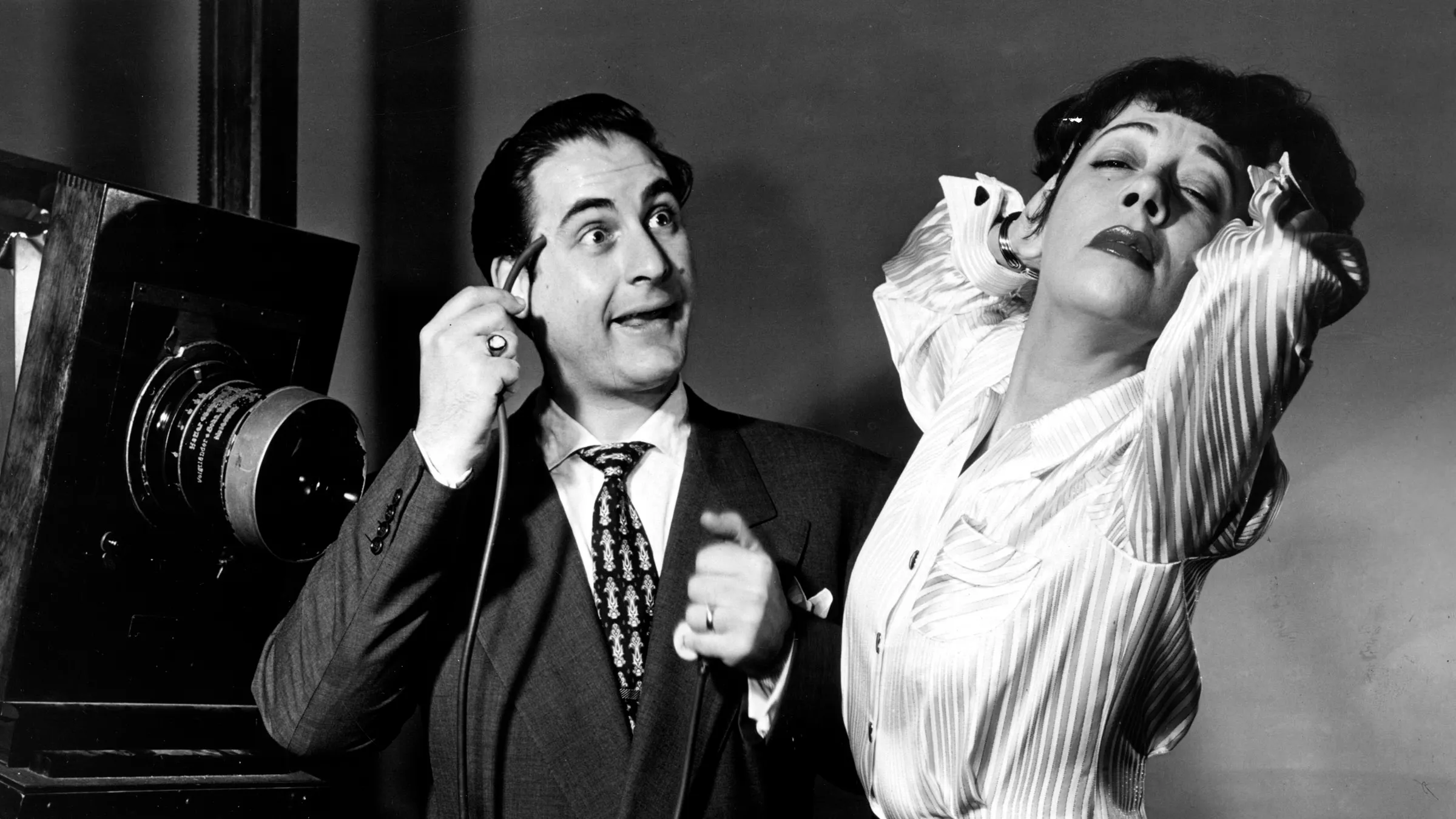Copyright newyorker

“Every gag that can possibly be told,” he once remarked, “has already been told, but there’s something funny in everything, even the way a man opens a door or sits down to read a newspaper.” Standup wasn’t his thing. He wasn’t political or hip. Working from observation—sometimes affectionate, sometimes withering—he created characters. He could play a genteel clerk, polite but so lustful that he can’t handle a cup of tea without scalding the woman he’s smitten with; as he wrecks her parents’ house, his manners never fail. The external world threatened Caesar less than the vexations of ordinary life. He and his performing partner, the saucer-eyed Imogene Coca, who was thirteen years older and half his size, played a married couple who’d open many episodes of the show. Their skits could be a little unnerving. A famished Caesar, longing for steak, gets taken by Coca to a pretentious health-food restaurant where he’s served a meal of beautifully arranged flowers. In another, she slowly lets him grasp that she has totalled his beloved car. Coca, flirting with the truth like a desperate teen, is the star of the scene, but the way Caesar’s rage and love for his wife play across his face is wonderful to watch. Capable of great delicacy in monologue and pantomime—he could convey the interiority of a six-month-old—Caesar was most brilliant as a man at the end of his tether. “Your Show of Shows” drew early TV owners in New York, Boston, Chicago, San Francisco, and Los Angeles—a well-off, educated crowd ready for whatever curves Caesar threw. He and his writers steered clear of politics but satirized the movies and TV of the moment. In the 1954 sketch “This Is Your Story,” they went after the treacly show “This Is Your Life,” which hauled unsuspecting guests before the cameras to confront their past—even survivors of the Holocaust and Hiroshima. (The latter was introduced to a member of the Enola Gay’s crew.) Caesar, as the aghast “Al Duncey of Darling Falls, Montana,” tries to bolt, only to be dragged back and drowned in maudlin hugs from relatives, including Uncle Goopy (Howard Morris), who clings to his leg like an aroused sloth. The laughter soon curdles: it’s a vision of how mass media can hijack private lives and dictate feeling. Pauline Kael, in a mixed 1973 appraisal of Caesar for this magazine, wrote, “I never felt that he personally was funny—that his core was funny.” I’d argue that his core was both funny and tragic, which explains his peculiar fate. He was a revolutionary talent whose particular success may have been possible only in a brand-new medium. The book, ardent yet measured, is unsentimental in a way few show-business bios are. Margolick has been a Times legal correspondent, and his books include “Strange Fruit,” his account of the Billie Holiday song. He’s an ideal cultural historian—curious and loving enough to incorporate every telling detail, but too wary of nostalgia to slip into ballyhoo. Entertainers tend to bend memory to their advantage; Margolick, contemptuous of myth, straightens the record, especially the legends spun by Mel Brooks, Caesar’s protégé. A small objection: Brooks is an exuberant fabulist, and I’m not sure fact matters more than art in his case. I’ll go on believing that Caesar, exasperated, once hung a noisy Brooks out of a Chicago hotel window to shut him up. When it comes to Caesar’s own recollections, Margolick knows that truth is hard to come by. Caesar wasn’t articulate, and what he later revealed about himself in his autobiographies sounds like guff. During the weeklong buildup to the broadcast, he was brooding and silent among his writers, springing to life only when he heard something he liked. He drank heavily, though not, he insisted, during working hours. When frustrated, he might put his fist through a wall or rip out a sink. Once, after a horse rolled over on his wife, he punched the horse—an episode Brooks later stole for “Blazing Saddles.” Caesar loved Cadillacs, suits, cigars, and guns, one of which, loaded, he sometimes waved around the office. He prized his writers (“I’d like to have seen Edison ad-lib the electric light”) but made them prove themselves every week. At its peak, “Your Show of Shows” had twenty-five million viewers, and Caesar was hailed as a genius. Albert Einstein and Leonard Bernstein were fans; on Saturday nights, when the show aired, Broadway theatres went half empty. Yet Margolick chronicles Caesar’s miseries as well as his triumphs, and the story slides inevitably into sadness. In show biz, those whom the gods would destroy they condemn to live in Beverly Hills. After his second show, “Caesar’s Hour,” was cancelled, in 1957, he stopped drinking and lost weight. He lived for another fifty-seven years, during which he was never more than intermittently employed. How could so brilliant a talent have had so brief a run at the top? Caesar was never sure his parents loved him. A fear of abandonment and of the fragility of success (the luncheonette had been sold during the Depression) haunted him. A mediocre student, he was saved by chance. One tenant left behind a saxophone—a Selmer Cigar Cutter tenor—which Caesar claimed as his own, later saying that he was glad it hadn’t been a shotgun. He took lessons at the Hebrew National Orphan Home, practiced obsessively, and, as a teen-ager, played all over Westchester, then “in the mountains”—the Catskills, where pale, urban Jews came to gorge on sunshine, blintzes, and comedy. At hotels like the Avon and Vacationland, he watched the working comics, “picking up tools of the trade like rhythm, timing, discipline, and improvisation,” as Margolick writes, and soon began taking the stage himself. Caesar joined the Coast Guard in 1939, when he was seventeen, and married Florence Levy (once and forever) in 1943. In the Coast Guard, he performed in the service revue “Tars and Spars,” under the eye of Max Liebman, the extraordinary Vienna-born impresario, who could, despite shaky English, build a full musical at a Poconos resort in a week—dancers, jazz players, even opera singers—and then start over the next. He was rehearsing for an unknown future. “More than anyone else,” Margolick writes, “Max Liebman made Sid Caesar Sid Caesar.” In 1949, the Admiral Corporation, a television-set manufacturer, took the plunge into production, mounting the “Admiral Broadway Revue” on both the NBC and DuMont networks. Liebman produced and directed. A Variety headline read “Admiral Bows Sock Revue with Top Artists, Yocks, Sizzling Pace Comparable to Best Broadway Hits.” The theatre was still the gold standard, but Caesar himself, as the Chicago Tribune noted, was “one of the soundest arguments for buying a television set.” The performers on Admiral’s show were selling the hardware that made their performances possible. Admiral, bizarrely, gave the series up after half a season, preferring to spend its money on making more television sets than on production costs. (“We were cancelled because we were too good,” Caesar said.) In late 1949, one of Margolick’s heroes, the NBC vice-president Pat Weaver, rescued Liebman and his troupe. A high-minded man, Weaver believed that the country craved dancers and opera singers, as well as comics. On February 25, 1950, at 9 P.M., “Your Show of Shows” was launched. Much like “Saturday Night Live” a quarter century later, “Your Show of Shows” was hell to put together. It was ninety minutes long, week after week, with commercials often lasting no more than a minute, and without cue cards. (Caesar thought they stifled spontaneity.) Lodged between musical numbers, the comics, Imogene Coca among them, did six sketches, having already discarded dozens of ideas earlier in the week. On broadcast day, they rehearsed three times, with constant eleventh-hour subtractions and additions. When the show was over, the cast and writers would head to Danny’s Hide-A-Way, on Steak Row (East Forty-fifth Street), where Caesar would down a bottle of Stolichnaya and lead the others in a Trimalchian feast—sometimes throwing up, either from nerves or from the desire to keep eating. Caesar and Coca were soon joined on the show by the diminutive Howard Morris, whom Caesar could hoist from the ground and glare at face to face, and by Carl Reiner, tall like Caesar but as happy as Sid was miserable—the ideal second banana. Together, the four could send up almost anything: melodrama, tragedy, operetta, game show. Reiner joined the writers’ room, an orderly place at first but eventually the loudest, most combative fourteen-by-twenty enclave in New York. At various times, and in changing combinations, Caesar’s writers included Mel Tolkin (a doleful Ukrainian with serious literary tastes), Lucille Kallen (who later became a mystery novelist), Larry Gelbart (responsible for the TV version of “M*A*S*H” and most of “Tootsie”), Michael Stewart (the book for “Hello, Dolly!” and “Bye Bye Birdie”), Joseph Stein (the book for “Fiddler on the Roof”), Neil Simon, and, toward the end of Caesar’s eight-year run, Woody Allen. The room was hazy with cigar smoke and strewn with pastrami and coleslaw. Margolick devotes much space to the writers’ quarrels, their gripes, their resentment of one another. All were vying for Caesar’s approval, throwing their best lines at him, hoping to get their ideas into the show. Simon later turned the room itself into a comedy, “Laughter on the 23rd Floor” (1993), which made clear the general exasperation with yet another of the room’s stalwarts, Mel Brooks. Bearing rugelach, Brooks arrived late, shouted everyone down, and then—infuriatingly—made their work better. He wasn’t a starter, but he was an exquisite finisher, able to take a half idea and make it sing, and the others, for all their irritation, knew that they couldn’t do without him. They also admitted, ruefully, that their time with Caesar had been the greatest experience of their professional lives. Caesar and his team trusted their audience to understand movies—never more so than in their parody of a D. W. Griffith-style silent film, “The Sewing Machine Girl” (1953), starring a consumptive Coca mired in Victorian melodrama and pathos. The actors moved in jerky spasms, replicating a quirk that film lovers would catch: after 1928, with the introduction of the talkies, silent films were almost always projected at the wrong speed. At other times, the writers’ knowingness was fed by rage. In the classic skit “All Slicked Up” (1954), Caesar plays a German general and Howard Morris his adjutant, scurrying around his master as he dresses him. The general, obsessed with perfection, bellows, “Das Monokel ist geshmutzig!”—which is sort of Yiddish, sort of German. Lasting under eight minutes, the sketch evokes German uniform worship and the accompanying demand for humiliation as powerfully as the stern psychosocial analysis of the day did. Margolick argues that Caesar avoided topical satire out of fear. Except for Coca, the principals were Jews, and though Jews were prominent in film, theatre, and the networks, there was enough antisemitism around to make them cautious. Still, a second-generation Jewish American sensibility permeated Caesar’s shows—not just in Yiddish tossed into barbarous tongues but in the pervasive mood of streetwise distrust. As Gelbart insisted, the show’s writers went to plays and read books; they were all in analysis. They knew how the world worked. Tolkin, Caesar’s head writer, was appalled by the sandy discomforts Burt Lancaster and Deborah Kerr must have endured making love on the beach in “From Here to Eternity.” In the Caesar parody, “From Here to Obscurity” (1954), Caesar and Coca writhe on the studio floor, doused again and again with buckets of cold water. That was broad enough comedy, but highbrow shenanigans can leave people feeling left out. In 1950, when “Your Show of Shows” began, nine per cent of American households had a TV set; by 1953, forty-five per cent did. Television had become a true mass medium, and Caesar saw his audience share shrink. In 1953, “Your Show of Shows” fell out of the top twenty-five Nielsen ratings (though it still drew sixteen million viewers). Margolick quotes letters to local newspapers from viewers almost vindictive in their displeasure. They felt that they were being condescended to. “Your Show of Shows” was expensive to produce, and, at the end of the 1954 season, NBC cut it down from ninety minutes to sixty as a new program, “Caesar’s Hour.” Caesar got a ten-year contract, but Liebman left to make color “specials,” and Coca was given her own show. (Brooks followed her briefly, then returned.) The core writers stayed on, and for three years “Caesar’s Hour” was often brilliant. But the ratings kept sliding, and, in 1955, the show ran into something unaccountable: Lawrence Welk, a Saturday-night bandleader who would turn to a row of trumpets and identically dressed party girls, wave his baton, and say, “anna one, anna two,” as bubbles drifted over the orchestra. Outraged, the Caesar gang struck back with “The Lonnie Bilk Show” (1956), with Caesar leading a band in a lopsided wig. They parodied Welk twice more, but the game was over. Always smiling, Welk offered the kind of soothing entertainment that small-town and rural viewers wanted, and he became a sensation. “These people,” Gelbart said later, “would have much rather seen bubbles coming out of Lawrence Welk’s ass than Sid Caesar doing a parody of ‘Rashomon.’ ” It’s tempting to see Caesar’s defeat as a watershed, an early culture-war skirmish between the wised-up urbanites and what one paper called the “still Christian soul of America.” But the shift was inevitable. By the mid-fifties, network TV had become big business; in 1955, gross revenues topped four hundred million dollars. TV schedules filled up with Westerns, detective shows, and easy-to-take comedies both gentle (“Ozzie and Harriet”) and rambunctious (“I Love Lucy”). The other funnymen of the time—Milton Berle with his lewd suggestiveness, Jackie Gleason with his baleful roar—did the same shtick over and over. Caesar cut closer to the bone. Amid parodies and marital sketches, he’d deliver a drunkard’s solo rant, or play a teetotaller undone by a single drink. His face could collapse in shame, his jaw sliding sideways; neither Goya nor Ensor painted despair more vividly. He even created a full musical episode, “The Dancing Towers” (1956), featuring a star dancer who can’t stop eating. Was he confessing his own troubles? Psychoanalysis licensed his candor, but the audience didn’t always join him on the couch. Some of his comedy was harrowing, including parts of “The Dancing Towers”—closer to “Long Day’s Journey Into Night” than to “Singin’ in the Rain.” By the late nineteen-fifties, he had entered his long second act. At the tributes, everyone hailed Sid Caesar as one of the great comics, yet no one knew what to do with him. Healthy at last, Caesar was also tame—perhaps he needed gluttony and drink to be great. The Queens Boulevard macher had become a Beverly Hills elder statesman: svelte, a little vague, and not always funny. Like Orson Welles, he haunted late-night talk shows as an impotent ghost. Caesar was undone by both his own vulnerabilities and the changing economics of broadcast television. When NBC was finished with him, it was so careless that it failed to preserve the existing records of his shows—the kinescopes, filmed directly off TV screens as the programs aired. Fortunately, many privately held reels have survived. They’re a little blurry, but Margolick makes the achievements of Caesar and his gang shine through. Caesar may rise again—in the love of young comics willing to push themselves, and their audiences, further than either wants to go. ♦



